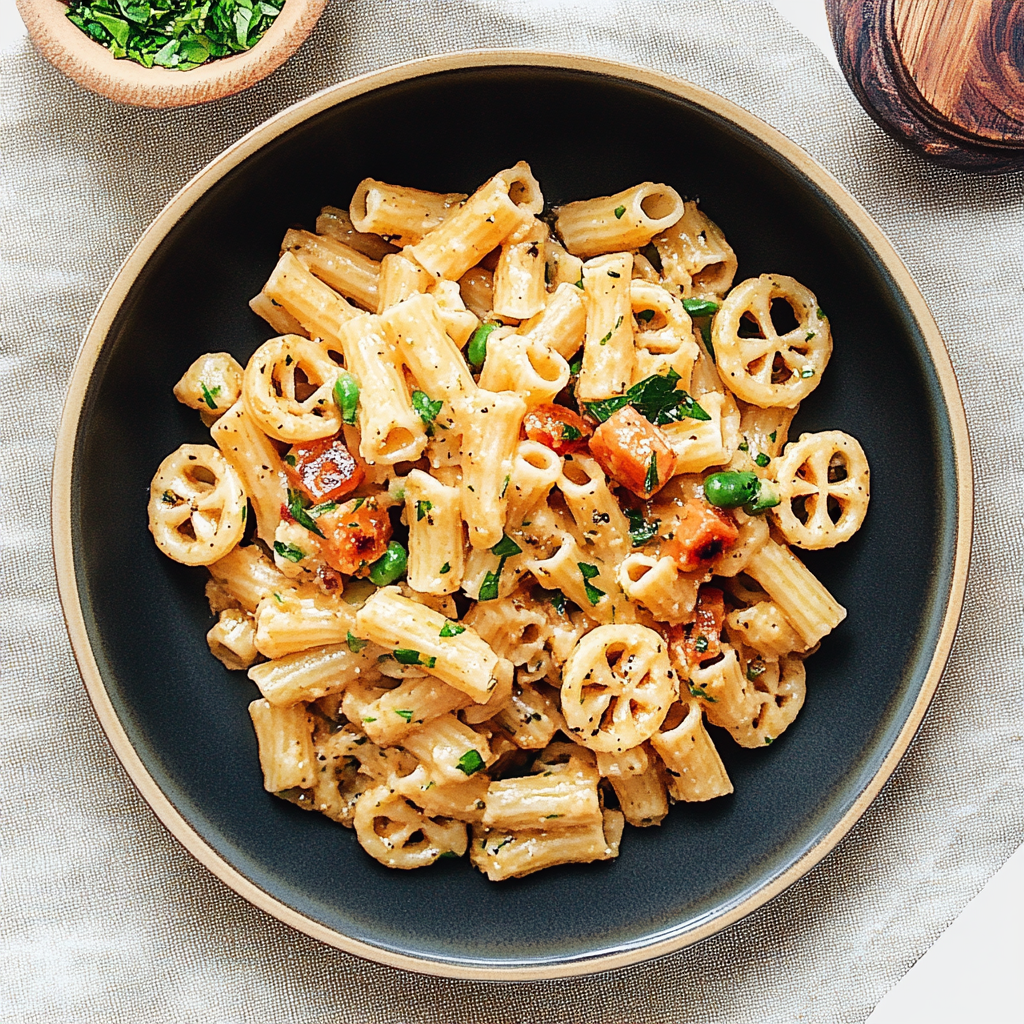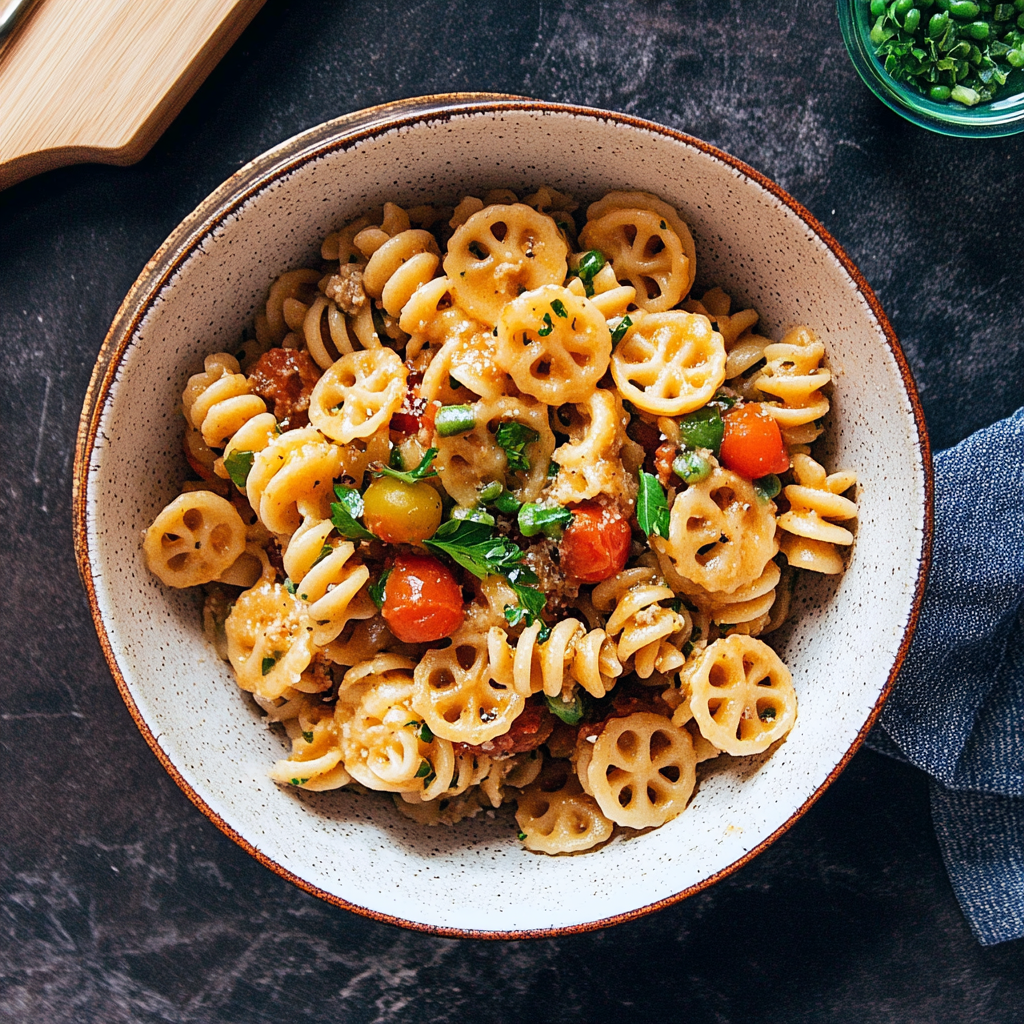Introduction
If you’ve ever tried a dish featuring wagon wheel pasta, you know just how fun and versatile it can be. With its charming, wheel-like shape, this pasta isn’t just for kids although they certainly love it! Whether you’re making a hearty soup, a creamy casserole, or a light pasta salad, wagon wheel pasta can add a playful twist to your meal. But beyond its looks, it also offers a variety of health benefits and serves as a perfect ingredient in many creative dishes.
In this article, we’ll dive into everything there is to know about wagon wheel pasta. From its origins and different types to delicious recipes and nutritional benefits, we’ve got it all covered. Whether you’re new to this pasta shape or a seasoned fan, there’s something here for everyone.
What is Wagon Wheel Pasta?
Understanding Wagon Wheel Pasta: A Unique Shape for Every Meal
Wagon wheel pasta is a playful, fun shape that’s both familiar and delightful. Named for its resemblance to an old-fashioned wagon wheel, this pasta is round, with spokes that radiate out from the center. Its unique shape allows it to hold onto sauces and other ingredients, making it a favorite in everything from creamy casseroles to fresh pasta salads. The pasta’s shape, combined with its bite-sized nature, makes it a hit with both children and adults alike.
The Origins of Wagon Wheel Pasta: From Tradition to Trend
The wagon wheel shape has deep roots in Italian culinary traditions. Like many pasta shapes, it was initially designed for practicality its round shape and ridges helped it hold sauce more efficiently. While it’s unclear exactly when or where it was first made, the wagon wheel pasta became popular in the United States in the mid-20th century. Its appearance often makes it a great addition to pasta dishes for kids, who are drawn to its fun, playful form.
Ingredients Typically Found in Wagon Wheel Pasta Dishes
What exactly is wagon wheel pasta made from? Typically, like other traditional pasta, it’s made from durum wheat semolina or flour and water. However, it’s now available in various forms, such as whole wheat and gluten-free options, for those with dietary restrictions. Whether you’re making it at home or buying pre-made versions, the base ingredients are simple, which makes this pasta easy to incorporate into just about any dish.
For example, you can pair wagon wheel pasta with vegetables, sauces, meats, or cheeses to create mouthwatering meals that satisfy the whole family. The texture of the pasta holds up well to both light and hearty sauces, making it incredibly versatile for any occasion.
Common Dishes Featuring Wagon Wheel Pasta
From hot meals to chilled options, wagon wheel pasta plays a starring role in a variety of recipes:
- Soups: The pasta’s shape size and structure make it ideal for soups and stews. It soaks up flavors and complements brothy dishes beautifully.
- Salads: Chilled pasta salads with fresh vegetables and dressings make the most of the pasta’s ability to hold onto flavors.
- Casseroles: Wagon wheel pasta pairs beautifully with creamy sauces and melted cheese in casseroles.
- Stir-Fries: For a fun twist, you can even use this pasta in a quick stir-fry, adding color and texture to the dish.
Types of Wagon Wheel Pasta and Cooking Techniques
Exploring Different Varieties of Wagon Wheel Pasta
When it comes to wheel-shaped pasta, there’s more than meets the eye. While its distinctive shape makes it a fun addition to any dish, the various types available offer even more options for creative cooks. From classic varieties to gluten-free options, let’s explore the different kinds and the best ways to prepare them.
Classic Wagon Wheel Pasta
Characteristics and Traditional Recipes
The classic version of this pasta is the most widely recognized. With its signature wheel shape and spokes, it’s the pasta most people picture when they think of this fun type. Typically made with durum wheat semolina, this pasta is firm and holds its shape well during cooking. Its texture makes it ideal for a variety of sauces, from rich tomato-based ones to creamy, cheesy casseroles.
This pasta is often used in hearty, comforting dishes like tomato-based pasta salads or baked casseroles. The ridged shape works well for catching thicker sauces and ensuring they stick to each bite. Many traditional recipes also incorporate it into soups, where it absorbs the broth while adding texture and heartiness.
How It Compares to Other Pasta Shapes
Compared to other shapes, this pasta has a distinct advantage when it comes to holding sauces. While traditional shapes like spaghetti or penne also pair well with sauces, the structure of this pasta allows it to trap more sauce in its spokes. This makes it a popular choice for dishes with thick, chunky sauces or rich broths.
Unlike spiral pasta, which coils similarly, the wheel shape adds an extra dimension with its circular spokes, making it both functional and visually appealing. Compared to smaller pasta shapes, like elbow macaroni, the roundness and size of this type offer more variety in your meals.
Health Benefits of Whole Wheat Pasta
Whole wheat wheel-shaped pasta is an excellent choice for those looking to make their meals healthier. Unlike regular white pasta made from refined flour, whole wheat options use whole grains, preserving more nutrients. The result is a slightly nuttier flavor and chewier texture, which can bring added depth to your dishes.
Whole wheat pasta is richer in fiber and contains more vitamins and minerals, such as magnesium, iron, and B vitamins. The higher fiber content aids digestion, helps regulate blood sugar levels, and can promote a feeling of fullness making it ideal for those watching their weight. It’s also a great option for those looking to eat a more nutrient-dense, balanced diet.
Gluten-Free Alternatives for Sensitive Diets
For those with gluten intolerance or celiac disease, gluten-free pasta offers a safe and tasty alternative. Made from rice flour, corn flour, or a blend of gluten-free grains, this pasta mimics the texture of the traditional version without the gluten.
Though gluten-free pasta can sometimes differ in texture, many find it works perfectly in the same dishes. Whether you’re preparing a cold pasta salad or a warm casserole, gluten-free options can still hold their shape and absorb sauces well. Some gluten-free varieties also include added fiber or protein, making them a healthier option for those on specialized diets.
Homemade vs. Store-Bought Pasta
The Process of Making Homemade Wheels
Making homemade wheel-shaped pasta is a fun and rewarding process. While it requires a little time and patience, the results are worth it. Start with a simple dough made from flour, eggs, and water. Knead and roll out the dough, then use a special pasta cutter or cookie cutter to shape the pasta into wheels.
Once shaped, homemade pasta can be cooked right away or dried for later use. Homemade pasta typically has a more delicate texture and richer flavor than store-bought versions. Plus, you can experiment with different flours, like semolina or whole wheat, to create unique variations.
Pros and Cons of Store-Bought Pasta
Store-bought wheel-shaped pasta is convenient and quick to use, making it a favorite for busy home cooks. It’s widely available and comes in various shapes, including classic and mini versions. However, it lacks the freshness and depth of flavor that homemade pasta offers.
Though store-bought pasta is made with durum wheat and is easy to cook, for those with specific dietary preferences or who want a fresher taste, making your pasta might be a more rewarding choice.
Cooking Wagon Wheel Pasta
How Long to Cook It Perfectly
To cook this pasta to perfection, boil it in plenty of salted water. The general rule is 8-10 minutes, but it’s always best to check the package instructions. Homemade versions may cook a bit quicker due to their freshness.
When cooked al dente, the pasta should be firm yet tender. Be sure to taste it before draining, especially if you’re using it in a casserole, as it will continue cooking in the oven. For soups, aim for a tender texture while maintaining the pasta’s shape.
Tips for Avoiding Overcooking and Retaining Texture
One of the biggest challenges when cooking this pasta is preventing it from overcooking and becoming mushy. Here are some tips:
- Stir the pasta frequently to prevent clumping.
- Test for doneness a minute before the recommended time.
- Drain it immediately and toss with olive oil if not using right away.
- For dishes like casseroles or soups, slightly undercook the pasta so it doesn’t get too soft.

Creative Recipes Using Wagon Wheel Pasta
Delicious Recipes Featuring Wagon Wheel Pasta
Isn’t just fun to eat, it’s also a great ingredient for a variety of mouthwatering dishes. From light, refreshing salads to hearty, comforting pasta dishes, wagon wheel pasta can be used in so many creative ways. Let’s dive into some easy and delicious recipes that highlight this unique pasta shape.
Wagon Wheel Pasta Salad
Simple, Healthy Ingredients for a Perfect Salad
Wagon wheel pasta salad is a fantastic dish that’s perfect for a summer picnic, a quick weeknight dinner, or as a side for a family gathering. It’s fresh, easy to make, and full of healthy ingredients. You can start by boiling some wagon wheel pasta, then tossing it with an assortment of vegetables such as cherry tomatoes, cucumbers, red onions, and bell peppers. To elevate the dish, add some fresh herbs like basil or parsley for extra flavor.
The key to a great pasta salad is a well-balanced dressing. You can make a simple vinaigrette using olive oil, lemon juice, a touch of Dijon mustard, and salt and pepper. If you prefer a creamier version, try using Greek yogurt or mayonnaise as a base, mixing in a little garlic powder, vinegar, and honey for sweetness. For a tangy twist, consider adding some crumbled feta or grated Parmesan cheese to your salad.
One of the best things about wagon wheel pasta salad is how flexible it is you can adjust the ingredients based on what’s in season or what you have in your pantry. The pasta’s shape holds the dressing well, so you get a flavorful bite with every forkful.
Variations of the Wagon Wheel Pasta Salad
While the classic version is always a hit, there are endless variations you can try. For example:
- Mediterranean Pasta Salad: Add Kalamata olives, sun-dried tomatoes, and cucumber to your wagon wheel pasta salad for a Mediterranean flair. Toss it with a lemon-oregano dressing and a handful of fresh mint leaves for a vibrant, fresh flavor.
- Grilled Veggie Pasta Salad: Grill some zucchini, eggplant, and bell peppers, and then chop them into bite-sized pieces. Add these to your wagon wheel pasta with a simple olive oil dressing for a smoky, savory flavor.
- Chicken and Bacon Pasta Salad: For a heartier salad, add some grilled chicken and crispy bacon pieces. You can even toss in a bit of ranch dressing to complement the savory elements. This version is perfect for a summer barbecue or potluck.
- Vegan Wagon Wheel Pasta Salad: For a plant-based version, use chickpeas or tofu in place of meat, and opt for a tahini-based dressing. Add avocado, cherry tomatoes, and arugula for a satisfying, nutritious salad.
The beauty of wagon wheel pasta salad is its versatility. You can easily swap out ingredients to fit your tastes, dietary restrictions, or what you have on hand.
Wagon Wheel Pasta with Tomato Sauce
A Classic Tomato Sauce Pairing with Wagon Wheel Pasta
For many, the combination of wagon wheel pasta and a rich, savory tomato sauce is a true comfort food classic. The round, ridged shape of the pasta is perfect for soaking up the delicious tomato sauce, making each bite burst with flavor. This dish is simple, affordable, and guaranteed to please.
Start by boiling the wagon wheel pasta until it’s perfectly al dente. While the pasta is cooking, prepare your tomato sauce. You can use a store-bought marinara sauce, but if you have the time, a homemade sauce will elevate the dish. A basic tomato sauce is made by sautéing garlic and onions in olive oil, adding crushed tomatoes, and seasoning with salt, pepper, dried oregano, and fresh basil. Let the sauce simmer for 15-20 minutes to let the flavors meld together.
Once the pasta is done, toss it with the tomato sauce, making sure every piece is coated. You can serve it as is, or for a heartier meal, top it with grated Parmesan cheese and a drizzle of extra virgin olive oil. For a more indulgent touch, add some mozzarella cheese and bake it in the oven until the cheese melts and gets golden brown.
Adding Protein – Ground Meat, Chicken, or Tofu
If you’re looking to add some protein to your wagon wheel pasta with tomato sauce, there are several great options to consider:
- Ground Meat: Ground beef, turkey, or pork work wonderfully in this dish. Brown the meat in a skillet, drain any excess fat and mix it into the tomato sauce for a hearty, satisfying meal. You can season the meat with garlic, onion, and Italian seasoning for extra flavor.
- Chicken: For a lighter option, grilled or roasted chicken works beautifully with wagon wheel pasta. Simply slice the chicken into strips or cubes and mix it into the pasta and sauce. The chicken will absorb the flavors of the sauce and provide a nice contrast to the texture of the pasta.
- Tofu: For a vegetarian or vegan option, tofu is a great addition. It absorbs the tomato sauce wonderfully, making it a perfect protein source. You can press and cube the tofu, sauté it until crispy, and then toss it in the sauce. For a more authentic Italian flavor, sprinkle in some nutritional yeast to add a cheesy flavor without the dairy.
- Meatballs: If you’re craving something extra comforting, try adding meatballs to your wagon wheel pasta with tomato sauce. You can make your own using ground beef or turkey, breadcrumbs, eggs, and a mixture of herbs, or use pre-made meatballs for convenience.
The combination of the rich tomato sauce and wagon wheel pasta pairs perfectly with these protein options, making it a well-rounded meal that everyone will enjoy.
Wagon wheel pasta is a versatile ingredient that can be used in both simple and complex recipes, making it a staple in any kitchen. Whether you’re preparing a fresh pasta salad or a hearty pasta dish with tomato sauce, there’s no shortage of ways to enjoy this fun and delicious pasta.
Frequently Asked Questions
What is a substitute for wagon wheel pasta?
You can use pasta shapes like rotini, fusilli, or cavatelli as substitutes. These shapes are similarly small and can hold sauces well, making them great alternatives in any dish that calls for wagon wheel pasta.
What is wheel pasta used for?
Wheel pasta, or wagon wheel pasta, is commonly used in casseroles, where its shape holds sauce and cheese perfectly. It’s also popular in pasta salads, adding a fun, bite-sized element, and works well in soups. Additionally, kids love it due to its playful shape, making it great for kid-friendly dishes.
Can any pasta sauce be a pasta bake?
While most sauces can technically be used in a pasta bake, heavier, thicker sauces like tomato-based (marinara, bolognese) and cream-based (Alfredo) work best. These types help the pasta stay moist and bind together in the baking process. Lighter sauces, like pesto or olive oil, might need extra cheese or moisture to ensure a creamy texture.
What is another name for wagon wheel pasta?
Wagon wheel pasta is also known as rotelle in Italian, meaning “little wheels.” It’s the same small, wheel-shaped pasta often used in fun, hearty dishes.
Conclusion
Wagon wheel pasta is not only a delightful and fun pasta shape, but it’s also incredibly versatile, making it a fantastic choice for a wide variety of dishes. Whether you’re tossing it into a fresh pasta salad, pairing it with a hearty tomato sauce, or baking it in a comforting casserole, wagon wheel pasta can elevate your meals with its unique shape and ability to hold sauces and flavors.
From classic dishes to creative new recipes, there are endless ways to enjoy wagon wheel pasta. You can opt for traditional versions or explore healthier alternatives like whole wheat or gluten-free options, catering to various dietary needs. Additionally, homemade versions allow you to get hands-on and truly customize your dish, while store-bought options offer convenience without compromising flavor.

